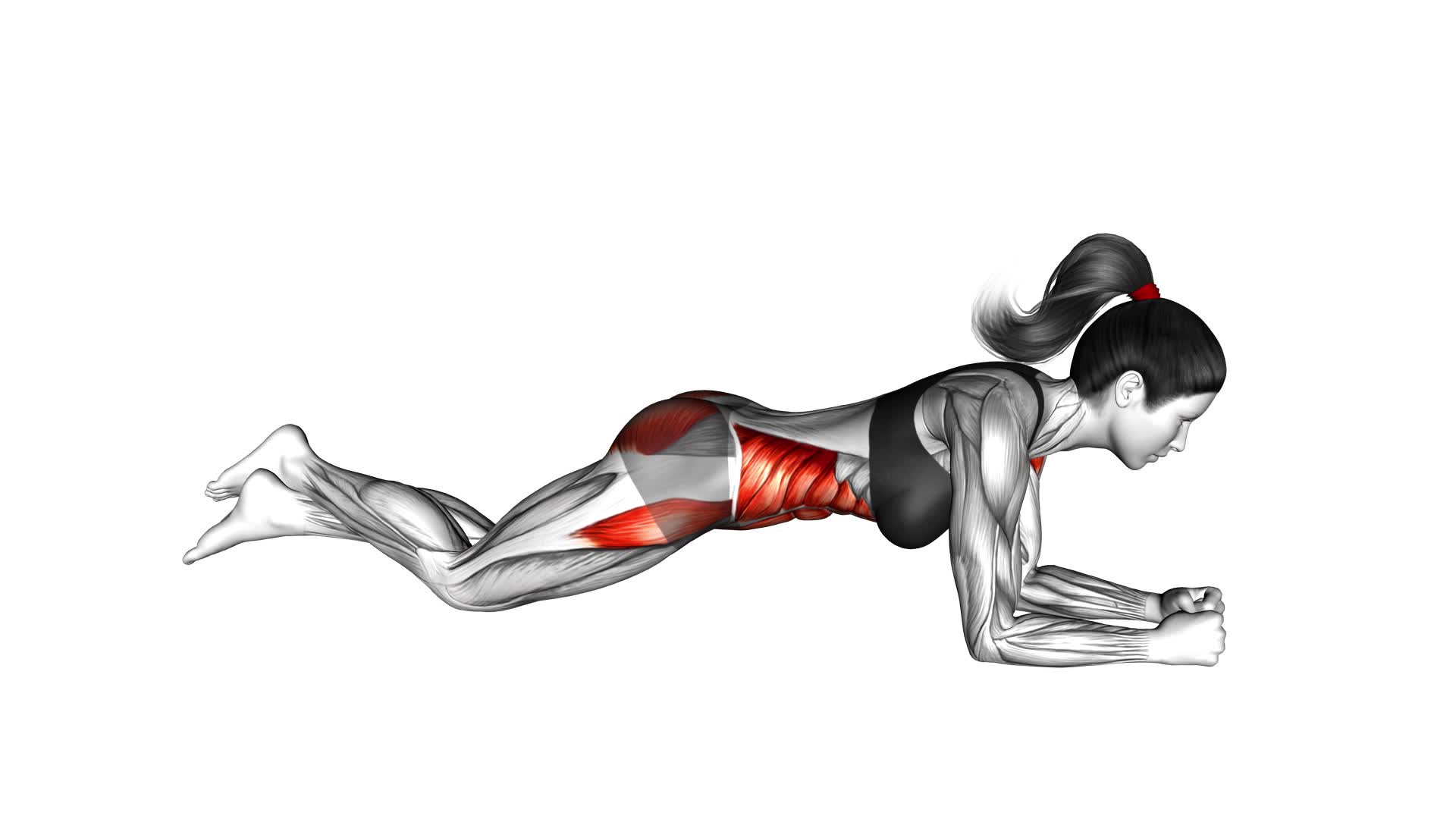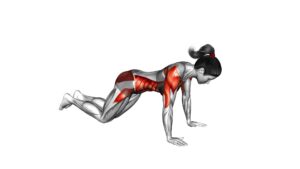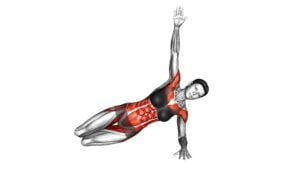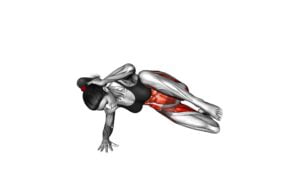Kneeling Plank (female) – Video Exercise Guide & Tips

Get ready to strengthen your core with the kneeling plank!
Watch This Exercise Video
This video exercise guide is packed with tips and tricks to help you perfect your form. Learn the proper set-up and alignment, engage those core muscles, and discover variations to challenge yourself.
Avoid common mistakes and get the most out of your kneeling plank.
Grab your mat and get ready to work those abs!
Key Takeaways
- The kneeling plank strengthens core muscles, improves posture and stability, and engages multiple muscle groups.
- It is a low-impact exercise suitable for individuals with joint issues or injuries.
- Proper set-up and alignment are important, including positioning hands under shoulders, engaging the core, keeping the back straight, and aligning the head with the spine.
- Variations and increasing intensity can provide additional challenges and target different areas of the core for a more intense workout.
Benefits of the Kneeling Plank
You can experience numerous benefits from incorporating the kneeling plank into your workout routine. This exercise is a great way to strengthen your core muscles, including your abs, lower back, and hips. By maintaining a stable and aligned body position, the kneeling plank helps improve your overall posture and stability. It also engages your glutes, shoulders, and chest muscles, giving you a full-body workout.
One of the key benefits of the kneeling plank is its ability to improve your core strength. As you hold the plank position, your core muscles are constantly engaged, helping to build strength and stability. This can lead to improved balance and coordination in your everyday activities.
Additionally, the kneeling plank is a low-impact exercise, meaning it puts less stress on your joints compared to other high-impact exercises. This makes it a suitable option for individuals with joint issues or those recovering from injuries.
To perform the kneeling plank correctly, start by getting on all fours with your hands directly under your shoulders. Extend your legs back, resting on your toes, and keep your body in a straight line from head to toe. Engage your core, squeeze your glutes, and hold this position for as long as you can without compromising your form.
Incorporating the kneeling plank into your routine can provide you with a range of benefits, from improved core strength to enhanced posture and stability. Give it a try and start reaping the rewards today.
Proper Set-Up and Alignment
To ensure proper set-up and alignment for the kneeling plank exercise, begin by positioning your hands directly under your shoulders while on all fours. This is a key step to ensure that your body is in the correct position and that you can perform the exercise safely and effectively.
Here are some important form cues to keep in mind:
- Engage your core by drawing your belly button towards your spine.
- Keep your back straight and avoid sagging or arching.
- Align your head with your spine by looking down at the floor.
- Maintain a neutral pelvis position by tucking your tailbone slightly.
By following these cues, you can ensure that you're maintaining proper form and alignment during the kneeling plank exercise.
It's important to note that modifications can be made to suit your fitness level and needs. For example, if you find it challenging to maintain the plank position on your toes, you can start by performing the exercise on your knees. Remember to listen to your body and make adjustments as necessary to prevent any discomfort or injury.
Engaging the Core Muscles
To engage your core muscles during the kneeling plank exercise, focus on tightening your abdominal muscles. Engaging your core is crucial for maintaining stability and proper form throughout the exercise. By contracting your abdominal muscles, you create a solid foundation and support for your body. This helps to prevent your lower back from sagging and ensures that your body remains in a straight line from your head to your knees.
Core stability is essential for overall strength and balance, which is why it's important to actively engage your core during the kneeling plank. This exercise targets not only your abdominal muscles but also your back, shoulders, and glutes. By engaging your core, you increase the effectiveness of the exercise and maximize the benefits for your entire body.
Once you have mastered the basic kneeling plank and have developed good core stability, you can explore variations to increase the difficulty. These variations challenge your core muscles even further and help you progress in your fitness journey. Some popular variations include the high plank, side plank, and walking plank. These variations target different areas of your core and provide a more intense workout.
Variations to Increase Difficulty
Now that you have mastered the basic kneeling plank, it's time to take it up a notch with some advanced variations.
These variations will help you increase the intensity of your plank and challenge your core muscles even more.
Advanced Plank Variations
Increase the difficulty of your plank workout by incorporating advanced variations. Take your core strength to the next level with these challenging plank progressions:
- Side Plank with Leg Lift: Start in a side plank position and lift your top leg straight up, engaging your core and glutes for stability.
- Plank with Knee Tucks: From a high plank position, alternate bringing your knees towards your chest, engaging your abs and challenging your balance.
- Plank with Shoulder Taps: Maintain a strong plank position while reaching one hand across to tap the opposite shoulder, focusing on stability and control.
- Plank Jacks: Begin in a high plank position and jump your feet out wide, then back together, engaging your core and legs for a cardiovascular challenge.
Incorporating these advanced core exercises into your routine will help strengthen your abs, improve stability, and take your plank workout to the next level.
Increasing Plank Intensity
To increase the intensity of your plank workout, try incorporating these challenging variations that will take your core strength to the next level.
One advanced modification you can try is the side plank with leg lift. Start in a side plank position with your forearm on the ground and your feet stacked on top of each other. Lift your top leg up and hold for a few seconds before lowering it back down. This exercise targets your obliques and adds an extra challenge to your plank routine.
Another way to increase the difficulty is by incorporating equipment, such as a stability ball. Place your feet on the stability ball while in a plank position, engaging your core even more.
These advanced modifications will help you push your limits and achieve greater results.
Challenging Kneeling Plank
To make the kneeling plank more challenging, incorporate variations that target different muscle groups and intensify the exercise. Here are some modifications you can try to increase the difficulty of the kneeling plank:
- Extended Arm Plank: Extend one arm forward while maintaining a stable plank position. This variation engages your core and upper body muscles even more.
- Knee Tucks: From the kneeling plank position, tuck your knees towards your chest one at a time. This adds instability and requires more core strength to stay balanced.
- Leg Lifts: Lift one leg off the ground while maintaining the kneeling plank position. This variation challenges your stability and engages your glutes and leg muscles.
- Mountain Climbers: From the kneeling plank position, alternate bringing your knees towards your chest in a running motion. This adds a cardiovascular element and increases the intensity of the exercise.
Incorporating these variations will help you increase stability and challenge yourself as you progress in your kneeling plank routine. Remember to start with modifications for beginners and gradually work your way up to more challenging variations.
Common Mistakes to Avoid
Avoiding common mistakes is key to performing the kneeling plank exercise correctly. By understanding and avoiding these errors, you can improve your stability and reduce the risk of injuries.
One common mistake is allowing your hips to sag or lift too high. To maintain proper form, aim to keep your body in a straight line from your head to your knees.
Another mistake is placing your hands too far forward or backward, which can strain your shoulders or wrists. Instead, position your hands directly under your shoulders for optimal support.
Additionally, avoid holding your breath during the exercise, as this can increase tension and decrease stability. Remember to breathe continuously and rhythmically throughout the movement.
Finally, rushing through the exercise is another mistake to avoid. Take your time and focus on engaging your core muscles to maintain stability and control.
Tips for Getting the Most Out of Your Kneeling Plank
To maximize the effectiveness of your kneeling plank, focus on maintaining proper form and engaging your core muscles. Here are some tips to help you get the most out of this exercise:
- Keep your wrists directly under your shoulders to ensure proper alignment and prevent strain on your joints.
- Engage your core by drawing your belly button towards your spine and squeezing your glutes. This will help improve stability and increase the effectiveness of the exercise.
- Maintain a straight line from your head to your knees, avoiding any sagging or arching of your back. This will help target your core and build upper body strength.
- Breathe deeply and evenly throughout the exercise, inhaling as you lower yourself down and exhaling as you push back up. This will help you maintain control and stability.
By following these tips, you'll be able to optimize your kneeling plank and make the most of your workout.
Remember to start slowly and gradually increase the duration and intensity of the exercise as you become more comfortable and stronger.
Frequently Asked Questions
How Long Should I Hold the Kneeling Plank Exercise?
To improve your core strength and reap the benefits of plank exercises, it's important to know how long to hold the kneeling plank exercise. Holding the position for 20-30 seconds is a good starting point, gradually increasing the time as you get stronger.
This exercise engages your abs, back, and shoulders, helping to stabilize your body and improve posture. Remember to maintain proper form and breathe deeply throughout the exercise for maximum effectiveness.
Can I Do the Kneeling Plank Exercise if I Have a Knee Injury?
If you have a knee injury, it's important to modify the kneeling plank exercise to avoid further strain.
Instead of putting weight on your knees, you can try doing a forearm plank or a side plank.
These alternatives will still engage your core muscles without aggravating your knee.
Remember to listen to your body and consult with a healthcare professional for personalized advice on exercises that are safe for your knee injury.
Is It Normal to Feel Discomfort in My Lower Back During the Kneeling Plank Exercise?
Feeling discomfort in your lower back during the kneeling plank exercise isn't uncommon. It could be due to improper form or weak core muscles.
To alleviate the pain, focus on engaging your core and maintaining a straight line from your head to your knees. Make sure to distribute your weight evenly and avoid arching your back.
If the pain persists, it's best to consult a professional for further guidance.
How Often Should I Incorporate the Kneeling Plank Exercise Into My Workout Routine?
To effectively progress the kneeling plank exercise and maximize its benefits, it's important to incorporate it into your workout routine consistently. By doing the kneeling plank exercise at least 2-3 times a week, you can build core strength, improve posture, and enhance overall stability.
Gradually increase the duration and intensity of the exercise to challenge your muscles further. Remember to maintain proper form and listen to your body to avoid any discomfort or injury.
Can I Modify the Kneeling Plank Exercise if I Have Wrist Pain or Weakness?
If you're experiencing wrist pain or weakness, you can modify the kneeling plank exercise to make it more comfortable for you. Instead of placing your palms flat on the ground, try using your forearms as a base of support. This will help alleviate the pressure on your wrists.
Additionally, you can explore alternative exercises that focus on core strength without putting as much strain on your wrists, such as side planks or bird dogs.
Conclusion
In conclusion, the kneeling plank is a highly effective exercise for strengthening the core muscles. By maintaining proper alignment and engaging the core, you can maximize the benefits of this exercise.
To increase the difficulty, try variations such as lifting one leg or adding a stability ball.
Avoid common mistakes like arching the back or sagging the hips.
By following these tips, you can get the most out of your kneeling plank workout.

Author
Years ago, the spark of my life’s passion ignited in my mind the moment I stepped into the local gym for the first time. The inaugural bead of perspiration, the initial endeavor, the very first surge of endorphins, and a sense of pride that washed over me post-workout marked the beginning of my deep-seated interest in strength sports, fitness, and sports nutrition. This very curiosity blossomed rapidly into a profound fascination, propelling me to earn a Master’s degree in Physical Education from the Academy of Physical Education in Krakow, followed by a Sports Manager diploma from the Jagiellonian University. My journey of growth led me to gain more specialized qualifications, such as being a certified personal trainer with a focus on sports dietetics, a lifeguard, and an instructor for wellness and corrective gymnastics. Theoretical knowledge paired seamlessly with practical experience, reinforcing my belief that the transformation of individuals under my guidance was also a reflection of my personal growth. This belief holds true even today. Each day, I strive to push the boundaries and explore new realms. These realms gently elevate me to greater heights. The unique combination of passion for my field and the continuous quest for growth fuels my drive to break new ground.







